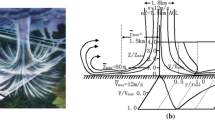Abstract
The aerodynamic characteristics of a square cylinder with an upstream rod in a staggered arrangement were examined. The pressure measurement was conducted in a wind tunnel at a Reynolds number of Re D =82,000 (based on the width of the square cylinder) and the flow visualization was carried out in a water tunnel with the hydrogen bubble technique at Re D =5,200. When the rod and the square cylinder were in tandem, the reduction of drag was mainly caused by the increase of the rear suction pressure. When the staggered angle was introduced, the shield and disturbance effect of the rod on the square cylinder diminished, which results in the increase of the cylinder drag. The side force induced by the staggered angle is small (the maximum value is 20% of the drag of the isolate square cylinder). There were six different flow modes with various staggered angles and spacing ratios, and the corresponding flow patterns are presented in present paper.











Similar content being viewed by others
References
Apelt CJ, West GS, Szewczyk AA (1973) The effects of wake splitter plates on the flow past a circular cylinder in the range 104<R< 5×104. J Fluid Mech 61:187–198
Bearman PW (1965) Investigation of the flow behind a two-dimensional model with a blunt trailing edge and fitted with splitter plates. J Fluid Mech 21:241–255
Bearman NS (1978) Drag reduction by polymers. Ann Rev Fluid Mech 23:65–79
Bearman PW, Obasaju ED (1982) An experimental study of pressure fluctuation on fixed and oscillating square-section cylinder. J Fluid Mech 119:297–321
Bouak F, Lemay J (2000) Reduction of unsteady lift and drag forces on a circular cylinder. In: Proceedings of the 6th triennial international symposium on flow control, measurement and flow visualization (FLUCOME 2000), Sherbrooke, Canada, August 2000, pp 13–17
Frenkiel FN, Landahl MT, Lumley JL (eds) (1977) Special issue of proceedings of the IUTAM symposium on structure of turbulence and drag reduction, Washington, DC, June 1976. Phys Fluids 20(10)
Igarashi T (1982) Characteristics of a flow around two circular cylinders of different diameters arranged in tandem. Bull Jpn Soc Mech Eng 25:349
Igarashi T (1997) Drag reduction of a square prism by flow control using a small rod. J Wind Eng Ind Aerodyn 69–71:141–153
Kwok KCS (1983) Effects of turbulence on the pressure distribution around a square cylinder and possibility of reduction. Trans ASME J Fluid Eng 105:140–145
Lesage F, Gartshore IS (1987) A method of reducing drag and fluctuating side force on bluff bodies. J Wind Eng Ind Aerodyn 25(2):229–245
Noda H, Nakayama A (2003) Free-stream turbulence effects on the instantaneous pressure and forces on cylinders of rectangular cross section. Exp Fluids 34:332–344
Prasad A, Williamson CHK (1997) A method for the reduction of bluff body drag. J Wind Eng Ind Aero 69–71:155–167
Roshko A (1954) On the drag and shedding frequency of two-dimensional bluff bodies. NACA technical note no. 3169
Sakamoto H, Haniu H (1994) Optimum suppression of fluid forces acting on a circular cylinder. ASME J Fluids Eng 116:221–227
Sakamoto H, Tan K, Haniu H (1991) An optimum suppression of fluid forces by controlling a separated shear layer from a square prism. ASME J Fluid Eng 113(2):183–189
Schlichting H (1979) Boundary-layer theory, 6th edn. Translation by Kestin J. Chaps 14 and 20. McGraw-Hill, New York
Tsutsui T, Igarashi T (2002) Drag reduction of a circular cylinder in an air-stream. J Wind Eng Ind Aerodyn 90:527–541
Walsh MJ (1983) Riblets as a viscous drag reduction technique. AIAA J 21:485–486
Wang JJ, Zhang PF, Lu SF, Wu K (2004) The effect of staggered angle on a passive drag reduction method of circular cylinder. In: Proceedings of the 13th European drag reduction meeting, Aussois, France, June 2004, pp 21–22
West GS, Apelt CJ (1982) The effect of tunnel blockage and aspect ratio on the mean flow past a circular cylinder with Reynolds number between 104 and 105. J Fluid Mech 114:361–377
Acknowledgements
The authors gratefully acknowledge the financial support from the National Natural Science Foundation of China for this work through grant NSFC 10272016.
Author information
Authors and Affiliations
Corresponding author
Rights and permissions
About this article
Cite this article
Zhang, P.F., Wang, J.J., Lu, S.F. et al. Aerodynamic characteristics of a square cylinder with a rod in a staggered arrangement. Exp Fluids 38, 494–502 (2005). https://doi.org/10.1007/s00348-005-0936-1
Received:
Revised:
Accepted:
Published:
Issue Date:
DOI: https://doi.org/10.1007/s00348-005-0936-1




